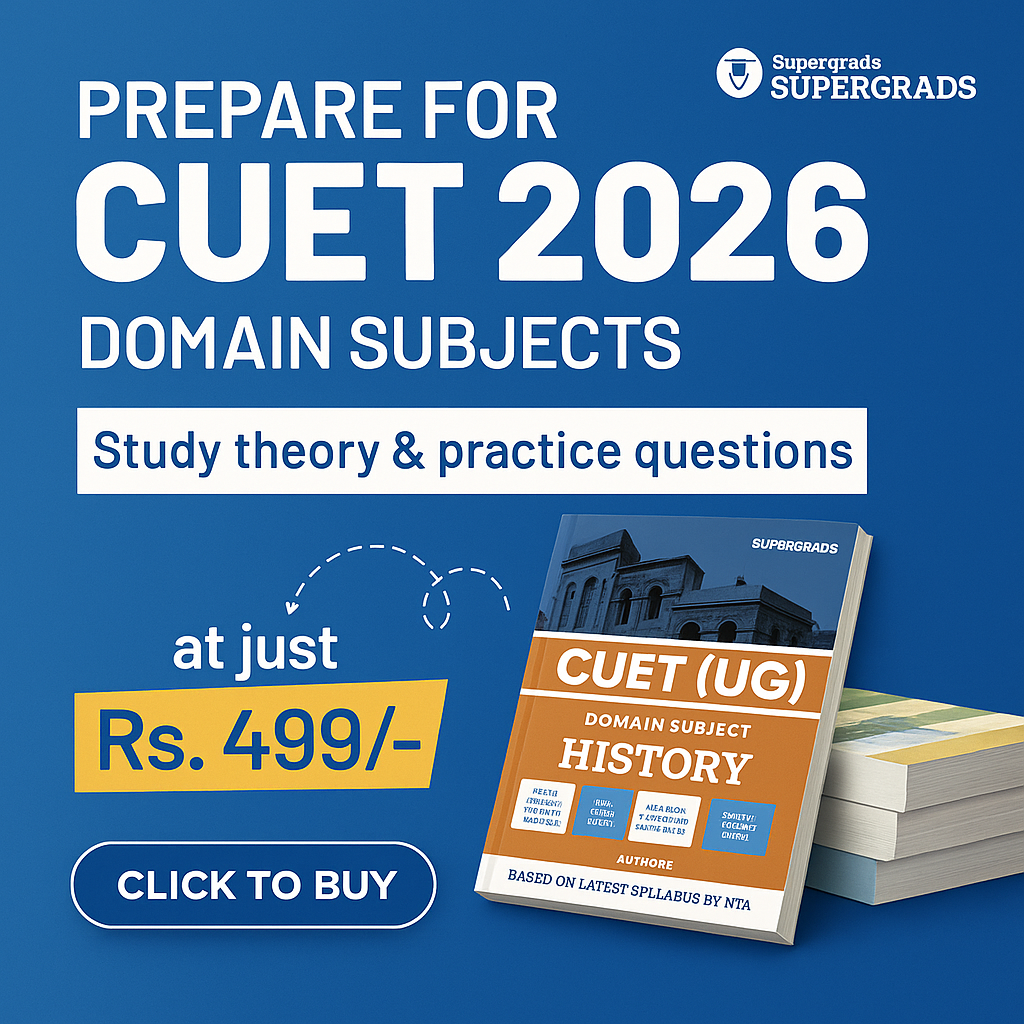CUET Commerce Question Paper Pattern & Sample Questions
November 19, 2025
Overview: Explore the structure, marking scheme & subjects of the CUET Commerce question paper. Unlock study strategies, previous year papers, and mock tests to ensure full marks in the CUET exam.
The CUET exam is your gateway to pursuing B.Com, B.Com(Honours) or subject specialization at India's premier universities. The CUET Commerce question paper is a significant challenge requiring thorough preparation, strategic planning, and an in-depth knowledge of the subject.
This article seeks to clarify the analysis of the CUET question paper Commerce, providing insights into the exam preparation strategies and the advantages of solving previous years' papers.
Note: The video is for 2024, but the content is relevant for CUET 2026 exam cycle also.
Understanding the CUET Commerce Question Paper
The CUET exam for Commerce subjects assesses your ability in core commerce disciplines such as accounting, business studies, economics, and mathematics (optional).
- The exam pattern consists primarily of multiple choice questions (MCQs), with questions such as case studies and data analysis based on the most recent exam pattern.
- Each paper is conducted separately in different shifts. Thus, the Commerce CUET question paper includes questions related to all the core disciplines for practice.
CUET Commerce Question Paper: Subject-wise Highlights
| Test Paper | Time (in minutes) | Total Marks |
| Accountancy | 60 | 250 |
| Business Studies | 60 | 250 |
| Economics | 60 | 250 |
| Mathematics (Optional) | 60 | 250 |
Sample CUET Commerce Question Papers PDF with Solutions
Download and practise from CUET Commerce previous year papers from the link below:
CUET Commerce Question Paper Pattern 2026
The CUET Commerce previous year question paper will be objective type. It will have only MCQs you must complete within the allotted time.
Make sure to go through the CUET Commerce Syllabus for efficiency and thorough preparation of these subjects.
The exam pattern for all the subjects included in commerce stream are:
| Test Paper | Questions to be attempted |
| Accountancy | 50 |
| Business Studies | 50 |
| Economics | 50 |
| Mathematics (Optional) | 50 |
The CUET exam pattern for Commerce is designed to assess your conceptual knowledge and application abilities in the question paper for CUET commerce subjects.
- The CUET Commerce question paper is divided into sections dedicated to a particular subject and containing questions of moderate to great difficulty.
- The marking method provides +5 marks for each right answer and -1 for each incorrect answer, emphasizing the significance of accuracy and well-thought-out attempts.
- Practice for each subject's important and scoring topics from the CUET sample paper for Commerce. It will help you boost your score.
Check: What type of questions are asked in CUET Exam
CUET Commerce Question Paper (Sample Questions)
Here are a few questions from the CUET Commerce sample paper paper with answers that you can practice from to have a look at the question type.
These questions and answers are designed to provide a comprehensive overview and allow you to practice key areas of commerce, assisting you in your CUET preparation for Commerce subjects.
1. What is the formula to calculate Gross Profit?
- A. Sales - Cost of Goods Sold
- B. Sales + Cost of Goods Sold
- C. Opening Stock + Purchases + Direct Expenses - Closing Stock
- D. Sales - (Opening Stock + Purchases + Direct Expenses - Closing Stock)
Correct answer: A. Sales - Cost of Goods Sold
2. The accounting principle that requires revenue to be recognized at the time of sale is:
- A. The matching principle
- B. The revenue recognition principle
- C. The historical cost principle
- D. The materiality principle
Correct answer: B. The revenue recognition principle
3. Which management level sets the organization's objectives and develops policies?
- A. Top-level management
- B. Middle-level management
- C. Lower-level management
- D. Operational management
Correct answer: A. Top-level management
4. Maslow's hierarchy of needs theory categorizes human needs into how many levels?
- A. 3
- B. 5
- C. 7
- D. 4
Correct answer: B. 5
5. If the price elasticity of demand for a good is less than 1, the demand is:
- A. Perfectly elastic
- B. Elastic
- C. Inelastic
- D. Unit elastic
Correct answer: C. Inelastic
6. Which market structure is characterized by a single seller and no close substitutes for the product?
- A. Monopoly
- B. Oligopoly
- C. Perfect competition
- D. Monopolistic competition
Correct answer: A. Monopoly
7. If the simple interest on a sum of money for 2 years at 5% per annum is $100, what is the principal amount?
- A. $1000
- B. $2000
- C. $500
- D. $2500
Correct answer: A: $1000 (Correct)
8. Which of the following is not a function of management?
- A. Planning
- B. Staffing
- C. Customer Service
- D. Controlling
Correct answer: C. Customer Service
9. The break-even point is the point at which:
- A. Total revenues equal total costs
- B. Total profit is maximized
- C. The company starts to experience losses
- D. Variable costs equal, fixed costs
Correct answer: A. Total revenues equal total costs
10. Depreciation is best described as:
- A. A method to increase the value of assets
- B. A process of allocation of the cost of a tangible asset over its useful life
- C. A way to calculate net income
- D. The reduction in sales revenue over time
Correct answer: B. A process of allocation of the cost of a tangible asset over its useful life
11. The principle of insurance that states that the insured should not collect more than the actual cash value of a loss is known as:
- A. Indemnity
- B. Contribution
- C. Subrogation
- D. Insurable interest
Correct answer: A. Indemnity
12. In economics, 'demand' refers to:
- A. The desire to own something and the ability to pay for it
- B. The total amount of goods produced
- C. Government regulations on trade
- D. The supply of goods available for sale
Correct answer: A. The desire to own something and the ability to pay for it
13. A company's total equity is calculated as:
- A. Total Assets minus Total Liabilities
- B. Total Liabilities minus Total Assets
- C. Total Revenue minus Total Expenses
- D. Total Expenses minus Total Revenue
Correct answer: A. Total Assets minus Total Liabilities
14. The term 'oligopoly' refers to:
- A. A market form in which a market or industry is dominated by a small number of sellers
- B. A market with only one buyer
- C. A market with only one seller
- D. A market with unlimited sellers and buyers
Correct answer: A. A market form in which a market or industry is dominated by a small number of sellers
Check: How To Attempt CUET Question Paper 2026
Paper-wise Analysis of the CUET Commerce Question Paper
As per the CUET commerce previous year question paper, subjects in commerce stream tests you based on:
- Accountancy: This paper tests your grasp of financial accounting principles, accounting standards, and the preparation of financial statements. Emphasis is placed on understanding and application rather than rote memorization.
- Business Studies: Questions in this section evaluate the understanding of business laws, management principles, and organizational behaviour. Case studies are common, requiring analytical skills to apply theoretical knowledge to practical scenarios.
- Economics: This paper covers both microeconomics and macroeconomics. It demands understanding economic theories, models, and their real-world applications. Data response questions test the ability to interpret economic data and graphs.
- Mathematics: The CUET Commerce question paper for Mathematics includes questions on business mathematics, statistics, and quantitative techniques, focusing on problem-solving and logical reasoning.
Check: CUET Last Minute Preparation Tips & Revision Techniques 2026
Benefits of Solving CUET Commerce Sample Paper
There are many benefits of solving week-wise CUET Commerce question paper of previous years and mock tests. The benefits include:
| Benefit | Description |
| Familiarity with Exam Pattern | It helps understand the structure, types of questions, and marking scheme, reducing exam-day anxiety. |
| Identification of Important Topics | It reveals the type of questions asked in CUET and important topics, allowing for a focused study. |
| Improvement in Time Management | It enhances the ability to manage time effectively during the exam |
| Accuracy and Speed | Regular practice improves speed and accuracy in answering questions. |
| Confidence Boost | CUET commerce previous year question paper builds confidence through familiarity with the question format and exam conditions. |
| Good Preparation | Aids in developing strategies for attempting the CUET question paper, such as which questions to tackle first. |
| Error Reduction | Solving CUET Commerce question papers helps identify common mistakes that can be avoided with practice. |
| Stress Management | Reduces exam stress through better CUET preparation and realistic expectations. |
| Regular Revision | Acts as an effective revision tool, enhancing recall value and knowledge and identifying weak areas. |
Check: CUET Study Plan 2026 to score 100%
Preparation Strategy to Solve CUET Commerce Question Paper
The preparation strategy should include:
Read: CUET Subject List for Commerce
Key Takeaways
- The CUET Commerce Question Paper includes separate tests for subjects such as Accountancy, Economics, Business Studies, and Mathematics.
- The question paper for each subject will be MCQ-based, and all 50 questions need to be attempted.
- Mastering the CUET Commerce subjects requires solving CUET mock tests regularly.
- Stick to your study plan and follow it diligently.
- Review the past year's exam analysis to know your target score and enhance your preparation.
Frequently Asked Questions
What subjects are included in the CUET Commerce Question Paper?

What type of questions can I expect in the CUET Commerce question paper?

How important is it to solve CUET Commerce previous year question paper?

Can I prepare for the CUET Commerce exam using only NCERT books?

What is the best strategy for attempting the CUET Commerce question paper?

How can I identify my weak areas in Commerce subjects for CUET?

What last-minute tips can help me perform better in the CUET Commerce subjects?




1750158060.webp)


1732085540.webp)




SHARE